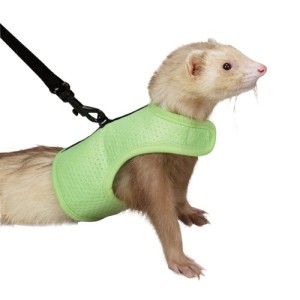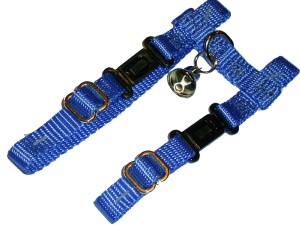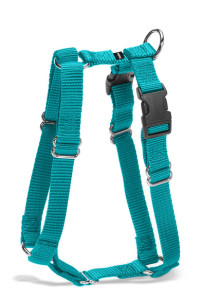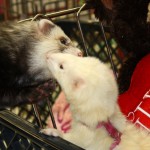The best harness is an H-style harness.
Never use only a collar with a ferret. If you put it on tight enough that it can’t come off, then it’s way too tight. If it’s too tight, the collar can choke the ferret or wear off the fur and cause a skin infection. In severe cases, the collar may become embedded in the skin and require surgery. The only safe and effective item is a harness. Never leave the collar/harness on while the ferret is in the cage (it could get caught on something and choke the ferret) and always supervise a ferret wearing a harness. I don’t use harnesses for inside the house; I only use them for walking ferrets.
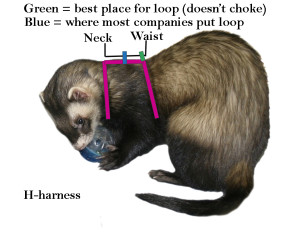 This is an example of a good harness. The straps are reasonably wide (not strings) to distribute the pressure. Ideally, the loop should come off the shoulders, but most companies put them halfway between the shoulders and the neck. If you find a harness that has the loop closer to one strap than the other, put it closer to the belly than the neck. Then when the ferret pulls, there isn’t as much pressure on the neck. Also, if you have a harness with a loop above the belly strap, you can “airlift” them without choking them if you run into danger while out walking.
This is an example of a good harness. The straps are reasonably wide (not strings) to distribute the pressure. Ideally, the loop should come off the shoulders, but most companies put them halfway between the shoulders and the neck. If you find a harness that has the loop closer to one strap than the other, put it closer to the belly than the neck. Then when the ferret pulls, there isn’t as much pressure on the neck. Also, if you have a harness with a loop above the belly strap, you can “airlift” them without choking them if you run into danger while out walking.
Don’t waste your money buying one of these. They are made from some kind of material that is almost foam-like. It’s too big, very hot and isn’t secure. You can’t adjust it properly. Some ferrets may learn to walk in one, but most just wiggle right out.
A ferret harness must be tighter than you would make a dog harness. You make it tight enough that you can slip one finger under it. More than that, and they just shrug it off.
When you first put a harness on your ferret, if they aren’t used to it they will claim you have crippled them for life. Don’t believe it! They will act like their legs don’t work, alligator roll, back all around the room trying to get it off and basically act like you’re killing them. Take them to a room where they aren’t normally allowed to play. Shortly, their curiosity will get the better of them and they’ll just start walking.
This is an example of a good harness. They’re called an “H-harness” because when viewed from the top, it looks like the letter “H”. If your ferret is an extreme escape artist and still gets out of this, add a strap under the belly (from the bottom of the neck loop to the bottom of the belly loop). That usually will keep them in.Some very tiny females are too small for most harnesses. In that case, you’ll have to shorten the straps a bit. I pinch up a bit of the strap and sew it (making a loop that sticks out on the outside of the harness). Then I sew that flat so it doesn’t look stupid. That will allow you to tighten it enough to keep your wily little girl safe.
Always test the harness and leash inside first. You don’t want to discover it’s too loose while you’re outside!
This is a harness for a cat or dog. If you could find one small enough, this would be ideal. The leash loop comes off the belly strap and there is an extra strap underneath. If you do find one like this small enough for a ferret, please let me know!There used to be a nice product called the Premier Ferret Fun 5-in-1 Ferret Harness/Leash. They discontinued the item! If you find one, buy it, because they aren’t made anymore.



